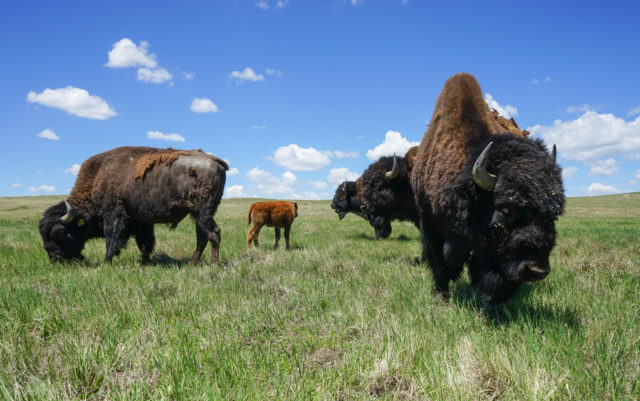
On Aug. 17, two dozen people — some sporting dresses and white sneakers, others cowboy hats and leather boots — lumbered into an open-top wagon fixed behind a white pickup truck. Hunter Lovins, a woman of the kind in a hat and boots, sat on the wagon’s wooden bench, arms draped in a “T” along its shoulder-high railings.
“This here is the future,” she says, nodding towards the golden-green grassland that rolls behind the truck to the horizon. The “this here” is the West Bijou — a 7,613-acre prairie owned by the Savory Institute, a Boulder-based nonprofit. The land is located 31 miles east of Denver and is sprinkled with bison and legendary fossils and minerals. On this
day, it’s being commemorated as the country’s newest National Natural Landmark (NNL), number 599 to date.
National Natural Landmarks are selected as “best examples” of a region’s natural biological or geological features. While the Secretary of the Interior designates sites around the country, landowners (30 percent of NNLs are privately owned) are instrumental in securing the designation and continue working closely with National Park Service (NPS) to promote conservation and protection of a given site even after gaining NNL status. Most such landmarks are relatively small and not necessarily frequented by the public, but they help ensure the preservation of the nation’s natural heritage.
Last November, former Secretary of the Interior Sally Jewell designated the West Bijou site as an NNL to recognize the land’s “incomparable contribution to the Earth’s geologic history through its unique features, including pollen records and vertebrate fossils,” according to a statement by the NPS. Perhaps most significantly, the West Bijou contains world-class geologic evidence of the asteroid scientists believe hit Earth and wiped out the dinosaurs 66 million years ago.
The truck pulls the wagon along the West Bijou’s dirt roads, bucking everyone into the air with each rut. It finally comes to a stop at a grassy overlook. White sneakers and boots clamber out and congregate. Down below, a handful of the land’s 400 bison graze alongside a wooded creek. To the east, a thin dark band of crumbling soil slices a line across the nearest hillside.
Ian Miller, a paleontologist at the Denver Museum of Nature and Science, steps up to speak about what makes this site of “exceptional value.” He points to the crumbling dark band of soil. “That is what is known as the K-T boundary. [That band] marks the point of dinosaurs going extinct.”

The K-T boundary (known formally as the Cretaceous-Tertiary boundary) tells the geologic story of one of the most important episodes in Earth’s history. The deposits found in this 1.18-inch-thick band of crumbly dirt are like bookmarks in the soil that explain the asteroid that caused the most recent of the Earth’s five mass extinctions, extinguishing the dinosaurs and eventually paving the way for the age of mammals.
“[Scientists from the museum] have been coming here to collect research for 20 years,” Miller says. There are 20 criteria that help science teams identify K-T boundary sites. “This is the only place we know of [in the world] that exhibits all 20.”
Below the boundary line, Miller and his team have uncovered parts of triceratops fossils, old trees immortalized in stone and deposits of particular metals and minerals. Above the line, only mammal bones exist, alongside ferns, some of the first greenery to resurface after the asteroid.
As Gov. John Hickenlooper noted last year, after news of the site’s designation: “These natural lands preserve our past, but also ensure that future generations can experience a bit of Colorado culture that can only happen when we work to protect them.”
On the grassy knoll, Jeff Orlowski, NNL regional coordinator, steps up to say, “Each [NNL] site is a page in the book of our national history. [We’re] pleased to partner with landmark owners, such as the Savory Institute, in support of their voluntary conservation of these important areas.”
He passes Daniela Ibarra-Howell, CEO and co-founder of the Savory Institute, a golden plaque honoring the West Bijou’s NNL status. It reads: “This site possesses exceptional value as an illustration of the nation’s natural heritage and contributes to a better understanding of the environment.”
The Savory Institute acquired the West Bijou earlier this year from the Aurora-based Plains Conservation Center, with whom they’ve worked closely for the past few years to secure the NNL designation.
Allan Savory, the Institute’s co-founder and namesake, first developed the organization’s holistic management practices in the 1960s. His vision has guided land and livestock managers around the world to optimize environmental, economic and social returns by honoring symbiotic relationships in an ecosystem. According to the Institute, Savory has influenced the management of over 18.5 million acres of earth.
While the K-T boundary’s geologic importance is readily recognized, Lovins — who is involved in researching the effects of holistic land management on the West Bijou, and who has numerous awards for her writing, teaching and consulting in the world of sustainable agriculture under her belt — makes clear the celebration this day is as much about the West Bijou’s future as it is about its past.

She says the Savory Institute’s land management practices on the West Bijou, which include a rotating fleet of bison and an emphasis on natural and sustainable agriculture, is not only marking a tremendous step forward in holistic land management and conservation, but also setting an example around the globe. Pairing respect for the land’s past with a healthy, innovative future epitomizes the Savory Institute’s holistic endeavour. “You see, this can be an example, a good example, of what we can do [around the world].”
The hundreds of bison trample, graze and fertilize the grassland. They’re shuffled around the land strategically, turning over the soil with their hooves, curating the short-grass prairie and distributing nutritious dumps as they go. Managing large herds of buffalo on these kinds of prairies can be one of the most effective ways to revitalize the natural landscape, the Savory Institute has found.
Before the boots and white sneakers pick their way down the slope to look at the K-T boundary up close, Ibarra-Howell closes out the ceremony: “We are thrilled to take on this stewardship of Colorado’s newest national landmark and believe that, through holistic management, the land, the people, and all native species including the bison, will thrive.”














